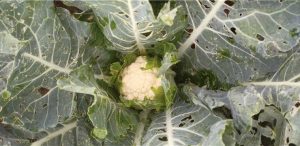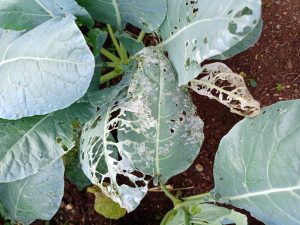If you’re currently growing or have plans to cultivate cruciferous crops such as cabbage, broccoli, cauliflower and kale, we have vital information that demands your immediate attention.
Have you heard about the diamondback moth? This tiny yet destructive creature has the power to destroy your entire yield if not managed effectively. Read on to discover the key insights that will safeguard your cruciferous crops from this pest, protect your investment and maximize your yield.
Diamondback Moth Symptoms in Crucifers
The larvae of the diamondback moth can cause damage to cruciferous plants through their feeding and mining activities. Look for the following symptoms that indicate their presence in the crops.
- Presence of whitish patches on leaves, as a result of the young larvae scraping (mining) the epidermal tissues.
- As the larvae progress to later instars, they primarily feed on the leaf surface, typically on the undersides of leaves, creating small, irregular holes.
- This gives the feeding site a window-like or shot-holes like appearance.
- The larvae feed the leaves voraciously and skeletonize the leaves by consuming the tissue between the leaf veins.
- Webbing or silk threads spun by the larvae for pupation can be observed on the undersides of leaves, leaf axils, or growing tips.
- Deformed or smaller heads in cabbage and other affected crucifers.
- Damage to the crowns or growing points of young plants, leading to growth stunting.
- Feeding on heart leaves before heading can affect flower production and yield in certain cruciferous crops.
- Presence of frass, i.e., excrement of the larvae on the leaves or often near the feeding sites.

Presence of window like or shot holes on the leaves 
Skeletonized leaves in infested cabbage leaves
Diamondback Moth in Crucifers Preventive Measures
- Avoid planting cruciferous crops in the same area year after year. Rotate your crops with legumes, cucurbits, onion, garlic to disrupt the moth’s life cycle and reduce the buildup of infestations.
- Remove crop debris and weed hosts after harvest to eliminate overwintering sites and reduce the chance of reinfestation.
- Use mustard as a trap crop, by cultivating two rows of mustard for every 25 rows of cabbage. You can either sow the first mustard crop 15 days before planting the cabbage, or plant 20-day-old mustard seedlings simultaneously with the cabbage.
- Set up pheromone traps to monitor adult moth populations.
- Plant early in the season to reduce exposure to peak moth populations.
Economic Threshold Level (ETL)
Watch out for the diamondback moth. When you spot 20 larvae per 10 plants, it’s time to take action and protect your crucifers.
Integrated Management of Diamondback Moth
If necessary, use chemical insecticides labeled for diamondback moth control as a last resort. Follow all instructions and safety guidelines provided on the product’s label.
| Product name | Technical content | Dosage |
| Mechanical Management | ||
| Tapas Diamondback moth lure | Trap | 3 traps/acre |
| Biological Management | ||
| Delfin Bio Insecticide | Bacillus thuringiensis var kurstaki | 1 gm/lit of water |
| Chemical Management | ||
| Coragen Insecticide | Chlorantraniliprole 18.5% SC | 0.1 ml/lit of water |
| Takumi Insecticide | Flubendiamide 20% WG | 0.5 gm/lit of water |
| Keefun Insecticide | Tolfenpyrad 15% EC | 2 ml/lit of water |
| Proclaim Insecticide | Emamectin Benzonate 5%SG | 0.5 gm/lit of water |
| Godrej Gracia Insecticide | Fluxametamide 10% EC | 0.8 ml/lit of water |
| Pegasus Insecticide | Diafenthiuron 50% WP | 0.5 – 1 gm/lit of water |





